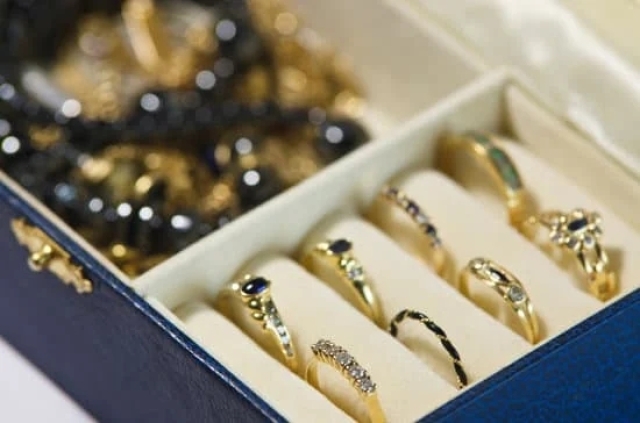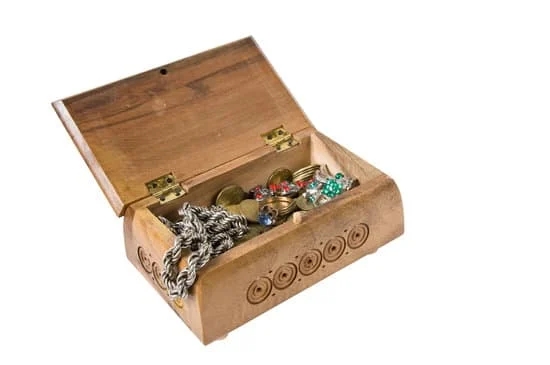The Egyptian Revival jewelry of the 1920s Art Deco period is one of the most iconic designs of this era. These pieces, popularized as “scarab” jewelry, were characterized by bold geometric shapes, vibrant enamel colors and exotic gemstones. During this time, Egyptians were believed to be descendants of god-like figures, much to the fascination of many in the Western world.
This reverence for ancient Egypt translated into a host of art and fashion that featured elements from its culture, such as papyrus scrolls and hieroglyphic symbols. Scarab jewelry was among these items, depicting motifs like hieroglyphs along with scarabs and sphinx heads rendered in gold.
Elements & Characteristics Egyptian Revival Jewelry usually features symbols derived from ancient monuments and sarcophagi – mainly scarabs and Pharaohs heads which are crafted into bracelets, pendants or necklaces. These pieces are typically decorated with colorful glazed stones such as lapis lazuli and turquoise, often set in heavily decorated gold settings with an engraved textured finish. The scarab beetle often appears in Egyptian artwork as it symbolizes eternal rebirth through self-renewal.
It is used to show continuity between generations due to its long lifespan. The Pharaoh head symbolizes power and strength while also representing rebirth – a popular theme across Ancient Egypt – attesting to their immortalities as gods on earth.
Impact On Popular Culture Egyptian Revival jewelry “Scarab” became highly fashionable in the 1920s Art Deco period due their intricate design details and familiarity these motifs had with popular culture at that time; even today people still appreciate them for their symbolic meaning.
This style continues to be seen on celebrities from around the world ranging from well-known fashion bloggers to Hollywood actors sporting a variety of pieces including earrings bracelets rings and necklaces made from materials like gold silver or brass accompanied by gemstones or enamels giving them a timeless yet daring look that adds interest to any outfit.
Additionally some brands have taken inspiration from this style by hand-crafting unique pieces based combining ancient cultural elements into modern silhouettes making them relevant today’s current trends.
History of the 1920s Art Deco Scarab
The 1920s Art Deco scarab originated in Egypt and draws on the ancient culture of the Egyptians with its distinctive shape and style. Scarabs were popular in Ancient Egypt as an amulet, or a small charm, depicting the outlines of a beetle used to ward off evil spirits.
The scarab was also frequently used for decorative purposes and carved out of both precious gems and stones, such as lapis lazuli. It was not until the 20th century that scarab jewelry became popular again.
Traditional Egyptian Revival Jewelry
In the early twentieth-century, Egyptian revival jewelry began to gain traction among fashion elites in Europe and America. While it drew elements from other cultures too, like Art Deco and Rococo influences, much of its aesthetics centered around hieroglyphics and depictions of gods like Horus, Isis and Anubis found in traditional Egyptian art forms.
Populated by enamel work featuring cobras, sphinxs, lotus flowers – symbolic motifs respectively representing life, death and rebirth – these pieces captured the romance of Ancient Nile Valley civilizations through their gold-plated construction; making them highly desirable for those embracing new traditionalism trends.
1920s Art Deco Scarab Revived
Within this period was where one could find examples of reminiscent designs capturing simplistic insects like beetles; taking influence from traditional aesthetic sensibilities such as Etruscan button brooches that had been popularized post-1800’s.
This is where one can find examples of Beetles depicted in Sterling Silver being featured not only in contemporary jewelry lines but also souvenirs from archeological sites like King Tutankhamen’s Tomb (1922) inspiring a global fascination with pharoanic empires; while accessingorizing iconic movie stars, nobility or politicians linked to modernity trends popping up across affluent society’s globally.
The Appeal Of The Scared Beetle
Scarabs held a unique spiritual significance as it was believed they brought good luck which made them especially attractive jewellery items when included within any accessories wardrobe since its association with protecting against negative energies potentially resulting from malign spirits or fate itself.
As a result this icon likely inspired many fictional works suggesting exploitation from figures like The Mummy (1932) also its plethora illustrated within Marvel Comics’ Doctor Strange series dating back to 1963 depicting mystical powers attained by holding it close to oneself while wearing it; triggering further imaginations amongst readers making it stand apart within usual diamond rings/necklace collections without having to breakdthe bank.
Materials Used in Egyptian Revival Jewelry
During the 1920s, Egyptian Revival jewelry, also known as Art Deco Scarab jewelry, was highly sought after. This style of jewelry was characterized by its designs and motifs that mimic ancient Egyptian iconography. Popular materials used in crafting this type of jewelry include gold, silver, metals such as brass or bronze, and gemstones like onyx, lapis lazuli, and carnelian.
One of the most popular symbols used in these designs is the scarab beetle. It has been revered since ancient times for its supposed powers of protection, transformation and renewal. The Egyptians also believed it to be a symbol of their sun god Ra and associated it with good fortune and life-giving energy from the sun. As such, these scarabs were often seen on necklaces and bracelets as well as engagement rings to represent love and fertility.
The combination of different metals set against precious gems also played a big role in helping craft pieces stand out from mainstream jewelry during this era. Gold provided an air of luxury while contrasting gems carried colorful symbolism that gave special significance to each piece. These specific colors were thought to promote mental clarity (blue), balancing (yellow) or joyfulness (green). In short, these combinations had emotional value that made them so popular among Egyptian revival fans at the time.
In addition to the choice in materials used for each piece was the technique employed in making them which required time-consuming detail work including delicate engravings into metal or set into perfectly cut stones for maximum sparkle when worn – further adding to appeal of 1930s art deco scarab jewelry and making it so coveted even today.
Notable Pieces of Egyptian Revival Jewelry
Egyptian Revival Jewelry has been a popular style of jewelry for centuries, as people have been inspired by the artwork and designs of ancient Egypt. During the 1920s Art Deco period, it saw a surge in popularity. This was especially true with scarab motifs, which have become a classic symbol of Egyptian-inspired jewelry.
Scarab motifs gave meaning to the Egyptian Revival jewelry pieces for fashion-savvy ladies. Scarabs were used to represent many positive messages including love, success and fertility.
The resurgence of Art Deco style during the 1920s, gave rise to scarab bracelets that feature geometric shapes often seen in this era’s iconic jewelry design such as circles and chevrons.
Notable Pieces Of Egyptian Revival Jewelry Include
- Scarab bracelets made from carved carnelian stones
- Enameled scenes featuring scarabs and other Egyptian symbols
- Fancy necklaces featuring symbolic hand engraved scarabs
- Sterling silver rings adorned with large amber or carnelian intaglio scarabs
- Retro-style pendants featuring mother-of-pearl enameled detail
Artistic and Cultural Influences of the Scarab in Ancient Egypt
The scarab is an ancient symbol of both spiritual and physical power. It was believed to be a protector against evil spirits in the afterlife, as well as a powerful amulet for good luck. For over 3,000 years, it has been prominently featured in Egyptian art and jewelry. During the 1920s, many pieces of Egyptian Revival jewelry were crafted featuring this iconic symbol.
Symbolism of the Scarab
The scarab was an important symbol of protection and resurrection in Ancient Egypt. The beetle’s form represented new life and immortality, similar to how pharaohs were believed to be reborn upon death. The power contained within the scarab was thought to guard the wearer from all sorts of evil spirits and dangers associated with them; it was even worn around necks or other body parts as a protective charm.
In addition to protecting its wearer, wearing a scarab also marked them as part of elite society; predominantly wealthier members proudly wore large jeweled specimens made from precious metals like gold or lapis lazuli as indicators of their social status. In fact, due to its popularity among royalty and nobility, wearing the scarab soon became a sign of wealth and privilege across all social classes in ancient Egypt.
Egyptian Revival Jewelry
Following Egypt’s rediscovery during Napoleonic’s expedition to Egypt during 1798-1801, its artifacts began gaining recognition worldwide for their intricate beauty and design characteristics – many jewelers started incorporating Egyptian motifs into their own designs around 1820. So called ‘Egyptian Revival’ styles emerged in French jewellery at this time which featured Cleopatra figures along with Scarabs, Winged Insects and Sphinx silhouettes.
Being cheaper than today’s mass produced jewelry – these pieces added prestige yet at an affordable price point so they became highly sought after by wealthy customers looking for something unique and stunning. Towards the end of 19th century – society eagerly embraced anything fantasy related which reflected an affinity towards Things Egyptian which has seen quite a resurgence today. This style prolonged into early 20th century with Art Deco type jewellery coming into fashion.
Even though simpler looking jewellery would become popular again – some people still preferred intricately designed jewels that had references to Greek, Romans or Ancient Egyptians. Those who chose these type of jewels showed off their attention to details when it came to fashion but sadly these items are very rare nowadays making them collectibles.
Cultural Meaning of the 1920s Art Deco Scarab
When looking at 1920s Art Deco style scarabs, the most evocative element is undoubtedly its cultural heritage. Egypt’s Ancient Pharaohs were among the most iconic rulers of antiquity and they served as inspirations for countless works of art throughout history. One of their most recognizable symbols is that of the Scarab beetle.
Egyptians believed that the Scarab beetle represented rebirth or transformation – two major themes in ancient Egyptian religion – making it a highly revered symbol in their culture and art. An Art Deco style Scarab necklace or brooch would have been seen as a direct homage to these beliefs.
The Influence of Egyptology on Art Deco Jewelry Design
The study of Egyptian tradition had already experienced something of a revival prior to the 1920s, largely due to Romantic era writers such as Jean-Francois Champollion and Giovanni Belzoni who reawakened people’s interest in the history and artifacts associated with Ancient Egypt.
This renewed fascination enjoyed widespread appeal in both Europe and America around this time due to its associations with mystery and spiritual enlightenment – perfect ingredients for fashion designers wanting to inject a sense of vibrancy into their clothing designs.
As such, motifs often associated with ancient Egypt, such as pyramids, obelisks, hieroglyphics, lotus flowers and scarabs became prevalent elements of Art Deco jewelry design.
Art Deco Jewelry Popularity Around The World
During the roaring twenties, young women around the world sought out jewelry which reflected their modern outlook on life; thus creating an incredibly popular demand for Art Deco jewelry styles such as necklaces featuring diamond-studded scrabs silhouetted against enamel backgrounds emulating various animal forms or a mix of bright colors typical harlequinstyles favored by fashionable young ladies throughout Europe during this time period.
Beyond just necklaces and brooches however, many ladies also adorned themselves with incredible rings featuring bezel settings surrounded by gemstones fashioned using methods reflecting old school jeweler craftsman skills believed to imbue pieces with greater meanings – yet another trait infusing elements from Ancient Egyptian designs into everyday fashion trends during this period.
How to Wear and Style Egyptian Revival Jewelry for Different Occasions
Many people are drawn to the fashion trend of Egyptian Revival jewelry from the 1920s Art Deco period. This type of jewelry has a unique aesthetic that is bold and eye-catching with its influences from ancient Egyptian art and motifs. Whether sporting a necklace, bracelet, earrings or rings; this look can easily transition from day to night.
One way to style Egyptian Revival jewelry for a daytime event is to pair it with something light and feminine such as a white dress or top. To make the outfit truly stand out add on some statement earrings or a layered necklace featuring layering charms and symbols inspired by mythological gods like falcons, ankhs and scarab beetles.
Furthermore delicate gold bangles adorned with blue enameled scarabs offer delicate yet stylish wristwear for day-to-day situations. If you prefer something more understated simply choose two focal pieces come accessorize accordingly – keeping the design classic instead of glamorous.
To wear Egyptian Revival jewelry for a formal event choose pieces with extra sparkle such as an eye catching collar necklace with pendants of Swarovski crystals. Rings featuring various colors gems set in 14k gold provide an elegant touch while dangling earrings add additional drama with minimal effort.
You may also opt to go even more bold with accessorizing by pairing multiple necklaces or bracelets together featuring interchanged pieces that blend seamlessly together for uniqueness galore. Another option would be draping yourself head to toe in pearls which were considered very fashionable during the ancient Mycenean era resulting in a timeless look no matter when you’re wearing them too.
Overall there’s no one wrong way when it comes to styling your wardrobe with Egyptian Revival jewelry pieces; just use your own creative vision and step out looking like the goddess you are.
Recommended Spots to Find the Best Quality Egyptian Revival Jewelry
Finding authentic Egyptian Revival jewelry can be a challenge. This is because the period of popularity for such an exquisite item did not last very long – it began in the 1920s and was considered to be over by the 1940s. Regardless, there are still plenty of places you can find vintage, high-quality pieces if you know where to look. Below are some recommended spots that will surely have something that meets your desires and budget.
The first spot to check when looking for Egyptian Revival jewelry is estate sales or auctions. These are usually held online or at local antique stores and they offer some of the best places to find items from this era.
They may sometimes even have rare pieces that don’t come up for sale often. You can also look for specific items like scarabs, which were popular symbols of rebirth in Egyptian culture, at these types of events or online shops dedicated to antiques and vintage fashion.
Thrift stores are another place to consider when searching for quality Egyptian Revival jewelry pieces as you often find older items still in pristine condition being sold at reasonable prices due to their age. Additionally, many thrift stores donate portions of their proceeds towards charity work or other projects so your purchase would be going towards a good cause too.
This type of store should definitely be checked out if you’re hoping to add some unique jewels into your collection while also helping people out in need.
Lastly, consider visiting flea markets near you. They are great places where dealers bring together various kinds of vintage items from all periods with amicable price tags if one is lucky to get a proper dealer. Oftentimes, things here can be found nowhere else so it might just surprise you what sorts of interesting showpieces turn up here.
No matter where you decide to go hunting for Egyptian Revival jewelry, make sure that it comes from an established source – either through a reliable dealer or secondhand store – so that you can ensure authenticity before making any purchase decisions. While no one place will always guarantee perfect finds, these suggested locations provide great chances at finding something that looks gorgeous without breaking your budget.

Welcome to my jewelry blog! My name is Sarah and I am the owner of this blog.
I love making jewelry and sharing my creations with others.
So whether you’re someone who loves wearing jewelry yourself or simply enjoys learning about it, be sure to check out my blog for insightful posts on everything related to this exciting topic!





